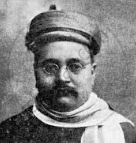Advertisements
Advertisements
प्रश्न
Read the extract given below and answer the questions that follow:
“… the Indians who actively worked for the creation of an all-India political organization represented new social forces that were increasingly opposed to the exploitation of India for British interests. They needed an organization that would fight for India’s political and economic advancement.”


From Freedom Struggle
Answer the following on the basis of above passage and pictures:
(i) In the context of the above, identify the two individuals in Pictures 1 and 2, who were the early leaders of the organization to be formed.
(ii) How did the person in Picture 1 explain the economic exploitation of India for British interest?
उत्तर
(i) The leaders given in picture 1 and picture 2 are Dada Bhai Naoroji and Gopal Krishna Gokhale respectively.
(ii) Through his famous ‘Drain Theory’ Dada Bhai Naoroji explained as to how India’ wealth is exploited for British interest in various forms such as:
(a) Salaries payable to the members of the India Council, (b) Dispatch of saving to England by British personnel posted in India, (c) Pensions to British Officers, (d) Payments to the war office for the maintenance of British troops in India.
APPEARS IN
संबंधित प्रश्न
Mention two administrative changes that the British Government brought about regarding the East India Company’s rule in India.
Name the two organizations, which merged in 1851 to form the British India Association of Bengal.
Name the Act of Lord Lytton’s regime, which aims at limiting the freedom of the Press.
Give any two reasons to indicate that the revolt of 1857 was an important landmark in India’s struggle for freedom.
There were various factors that promoted the growth of Nationalism in India in the 19th century. Give the meaning of ‘Nationalism’ in this context.
Give two reasons for industrial stagnation during the British rule in India.
Give two reasons for the resentment of the Indians against the British during Lord Lytton’s Viceroyalty.
What role did the press play in fostering political ideas and patriotic sentiments among Indians in the National Movement?
What was the aim and purpose of Ilbert Bill?
With reference to the growth of Indian Nationalism in the early phase, name a British viceroy who was very liberal in outlook and undid many repressive measures of his predecessor. Also discuss the role he played in the growth of Indian Nationalism.
